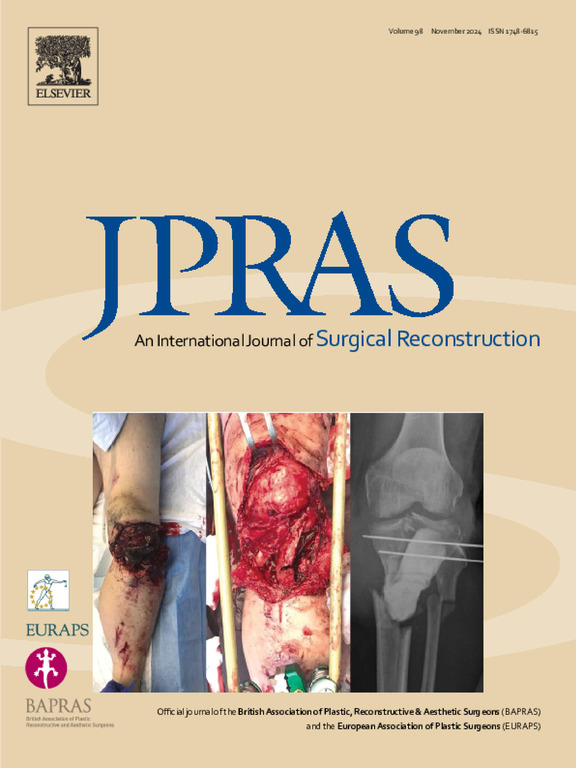Fat transfer for plantar heel pain: A retrospective case series
IF 2.4
3区 医学
Q2 SURGERY
Journal of Plastic Reconstructive and Aesthetic Surgery
Pub Date : 2025-06-03
DOI:10.1016/j.bjps.2025.05.039
引用次数: 0
Abstract
Background
Plantar heel pain (PHP) affects 4–7% of the population. It encompasses a range of different pathologies. Heel fat pad atrophy is thought to be the second leading cause of PHP. Atrophy of the heel fat leads to decreased cushioning over the calcaneus. The associated pain can be disabling and lead to reduced mobility and social isolation. This case series describes how fat transfer can alleviate symptoms of PHP.
Methods
Twenty-one procedures of fat transfer were performed using the Coleman technique for PHP between 2013 and 2023. All surgical candidates had clinical and/or radiological evidence of heel fat pad atrophy and suffered with intractable PHP. Other pathologies including plantar fasciitis were excluded prior to surgery. All surgical candidates undertook the Manchester-Oxford Foot Questionnaire (MOXFQ) Patient Reported Outcome Measure prior to surgery and at 3 months postoperatively. Average patient follow-up was 6.5 months.
Results
The median preoperative MOXFQ Index score was 70.5 (Interquartile range = 7.0). The median postoperative MOXFQ score was 33.0 (Interquartile range= 21.5). The median reduction in MOXFQ Index score was 37.0 (Interquartile range 27.5). Wilcoxon signed-rank test confirmed a statistically significant reduction in MOXFQ scores (p < 0.00001). Power analysis revealed an effect size of Cohen’s d = 2.03, with a statistical power of 1.0. There were no cases of reoperation. There were no recorded postoperative complications.
Conclusions
This case series study highlights the potential efficacy of autologous surgical fat transfer in alleviating intractable PHP associated with heel fat pad atrophy. This case series is limited by its small sample size and long study window. Despite initial and promising results, further research evaluating a larger cohort is warranted.
脂肪转移治疗足底跟痛:回顾性病例系列
足底跟痛(PHP)影响了4-7%的人口。它包含了一系列不同的病理。脚跟脂肪垫萎缩被认为是PHP的第二大原因。脚跟脂肪的萎缩导致跟骨的缓冲减少。相关的疼痛可能会导致残疾,并导致行动不便和社会孤立。本案例系列描述了脂肪转移如何减轻PHP的症状。方法2013 - 2023年,采用Coleman技术进行21例脂肪移植。所有手术候选人均有临床和/或放射学证据表明脚跟脂肪垫萎缩并患有难治性PHP。其他病理包括足底筋膜炎被排除在手术前。所有手术候选人在手术前和术后3个月接受了曼彻斯特-牛津足部问卷(MOXFQ)患者报告结果测量。患者平均随访时间为6.5个月。结果术前MOXFQ指数评分中位数为70.5(四分位数间距为7.0)。术后MOXFQ评分中位数为33.0(四分位数间距为21.5)。MOXFQ指数评分降低的中位数为37.0(四分位数间距为27.5)。Wilcoxon sign -rank检验证实MOXFQ评分有统计学意义上的显著降低(p <;0.00001)。功效分析显示效应量Cohen’s d = 2.03,统计功效为1.0。无再手术病例。无术后并发症记录。结论本病例系列研究强调了自体手术脂肪移植在缓解难治性PHP伴足跟脂肪垫萎缩方面的潜在疗效。本病例系列受样本量小和研究时间长的限制。尽管初步和有希望的结果,进一步的研究评估更大的队列是必要的。
本文章由计算机程序翻译,如有差异,请以英文原文为准。
求助全文
约1分钟内获得全文
求助全文
来源期刊
CiteScore
3.10
自引率
11.10%
发文量
578
审稿时长
3.5 months
期刊介绍:
JPRAS An International Journal of Surgical Reconstruction is one of the world''s leading international journals, covering all the reconstructive and aesthetic aspects of plastic surgery.
The journal presents the latest surgical procedures with audit and outcome studies of new and established techniques in plastic surgery including: cleft lip and palate and other heads and neck surgery, hand surgery, lower limb trauma, burns, skin cancer, breast surgery and aesthetic surgery.

 求助内容:
求助内容: 应助结果提醒方式:
应助结果提醒方式:


